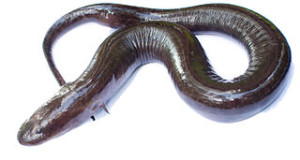Salamanders are not given nearly the attention they deserve by amphibian enthusiasts and, consequently, we know far less about their habits and care than we do of their more familiar relatives, the frogs. Many species, however, do very well in captivity and make long-lived (to over 50 years!) and responsive pets. A number are brilliantly colored, and all exhibit complex social behaviors and other traits that are easily observed in a properly designed captive habitat. I hope you will check out my book, Newts and Salamanders if you find these creatures as interesting as do I.
In contrast to frogs, salamanders reach their greatest diversity in temperate habitats – more species are found in the eastern USA than anywhere else on earth. Today I would like to take a look at the natural history of the spotted salamander – a large, local beauty that makes both an excellent “first salamander” and a fine addition to advanced collections. Next week I’ll cover their care in captivity.
Physical Description
Varies in length from 4 ¾ to 9 ¾ inches. Stoutly built, with a black or slate- colored body marked by irregular rows of brilliant yellow (occasionally orange) spots. Larvae are usually a uniform olive or brown in color with bushy red external gills.
Range and Habitat
Eastern and central North America – from Nova Scotia and central Ontario, Canada south to Georgia and west to eastern Iowa and eastern Texas. They are absent from southern NJ and the Delmarva Peninsula. Isolated populations are still to be found within NYC, on Staten Island and in Queens and the north Bronx.
Spotted salamanders favor deciduous lowland forests and meadows near forest edges and sometimes inhabit woodland patches within suburban areas. Adults require soil into which they can burrow and the fish-less bodies of water for breeding (the larvae are relatively defenseless against fish). Certain populations breed where fishes are present, but only if dense aquatic plant cover is available.
Spotted salamanders are members of the family Ambystomatidae – the mole salamanders. True to this name, the terrestrial adults spend most of their lives below logs or underground in self-excavated burrows or in those dug by mammals such as moles, shrews and field mice. They have been found at depths of 4 feet below ground, and generally forage on the surface only on damp or rainy nights. Spotted salamanders are sensitive to soil pH and avoid acidic soil.
Status in the Wild
Common in some parts of the range and drastically declining in others due to habitat loss – the removal of trees causes the soil to dry, and results in loss of the protective leaf-litter cover needed by this species. The introduction of trout and other game fish to breeding ponds quickly causes local extinctions.
Spotted salamanders typically breed in vernal (temporary) ponds, which are often small in size and only a few inches deep (these lack fish – see above). Unfortunately, such “puddles” are rarely recognized as worthy of protection, and hence are destroyed at a greater rate than are other habitats.
They are also threatened by acid rain and road-salting, both of which change soil and breeding pond pH, killing the larvae and driving off the adults. Protected by several states but not nationally, and not listed by CITES.
 That Reptile Blog – Reptile, Amphibian and Exotic Pet Care and Information
That Reptile Blog – Reptile, Amphibian and Exotic Pet Care and Information




2 comments
Pingback: The Spotted Salamander, Ambystoma maculatum – Part II, Natural History : That Reptile Blog
Pingback: The Spotted Salamander, Ambystoma maculatum, – Care in Captivity - Part 1 : That Reptile Blog